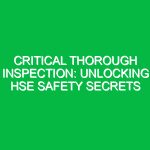Introduction
The skull and crossbones symbol represents a material that poses health Hazards, particularly in the context of Health, Safety, and Environment (HSE) regulations. Commonly associated with poison or Toxic Materials, this emblem is crucial for alerting individuals to potential dangers in various industries, from chemical manufacturing to agriculture. Understanding the significance of this symbol is not only essential for compliance but also for cultivating a culture of Safety in workplaces where hazardous substances are handled.
The history of the skull and crossbones dates back centuries, but its contemporary relevance in HSE cannot be overstated. It serves as a universal warning sign, conveying critical information about the risks associated with certain materials. In this article, we will explore the multifaceted implications of the skull and crossbones symbol, its regulatory framework, associated risks, and Best Practices for ensuring Safety in environments where these hazardous materials are present.
The Meaning Behind the Symbol
The skull and crossbones symbol represents a material that is toxic, hazardous, or potentially deadly. It is often used to denote substances that can cause serious health Effects, such as chemicals, poisons, and other dangerous materials. This symbol is part of a larger system of Hazard Communication standards, which aim to inform workers and the public about the risks associated with handling specific substances.
Historically, the skull and crossbones have been used in piracy, but its adoption in safety practices marks a significant shift towards protecting human health and the environment. The symbol is typically featured on labels, safety data sheets (SDS), and signage to ensure that individuals are aware of the potential dangers. Its presence serves as a reminder of the responsibilities that come with handling hazardous materials.
Key Aspects of the Skull and Crossbones Symbol in HSE
1. Regulatory Framework
The skull and crossbones symbol is governed by various Regulations and Standards aimed at promoting safety in workplaces. In many countries, the Globally Harmonized System of Classification and Labelling of Chemicals (GHS) outlines the criteria for labeling hazardous materials. Under GHS, the skull and crossbones icon is specifically used to indicate acute toxicity.
In the United States, the Occupational Safety and Health Administration (OSHA) mandates that employers provide adequate Training and information regarding hazardous materials, including those represented by the skull and crossbones. Similarly, the European Union has stringent regulations under the Classification, Labelling and Packaging (CLP) Regulation, which enforces the use of this symbol for toxic substances.
2. Hazard Identification
The skull and crossbones symbol represents a material that can lead to acute health effects, including poisoning or death upon exposure. Identifying Hazards associated with such materials is a critical aspect of HSE management. Common substances that may feature this symbol include:
- Pesticides
- Heavy metals (e.g., lead, mercury)
- Industrial chemicals (e.g., formaldehyde, cyanides)
- Pharmaceuticals (in certain contexts)
Proper hazard identification involves thorough risk assessments, which consider the physical and chemical properties of these substances, exposure routes, and potential health effects. This proactive approach allows organizations to implement appropriate controls and preparedness measures.
3. Safety Data Sheets (SDS)
Safety Data Sheets (SDS) play a crucial role in communicating information about hazardous materials. Each SDS must include sections detailing the hazards associated with the substance, recommended Safety Measures, and emergency response protocols. The skull and crossbones symbol is prominently displayed on the SDS for materials that pose acute toxicity risks, ensuring that anyone handling the material is immediately aware of the dangers.
An effective SDS will include:
- Identification of the substance and manufacturer
- Hazard identification
- Composition and information on ingredients
- First-aid measures
- Fire-fighting measures
- Accidental release measures
Workers should be trained to read and understand SDS documents, empowering them to respond appropriately in case of exposure or emergencies.
4. Personal Protective Equipment (PPE)
When working with materials that feature the skull and crossbones symbol, the use of Personal Protective Equipment (PPE) is essential. Depending on the nature of the material, recommended PPE may include:
- Gloves (chemical-resistant)
- Safety Goggles or face shields
- Respirators or masks
- Protective clothing (coveralls, aprons)
Employers should conduct thorough assessments to determine the appropriate PPE based on the risks associated with specific substances. Regular training and reminders about the importance of PPE can significantly reduce the likelihood of exposure.
5. Emergency Response Procedures
Having well-defined emergency response procedures when dealing with materials represented by the skull and crossbones symbol is vital. Organizations should develop plans that include:
- Immediate actions to take in case of exposure (e.g., washing affected areas, seeking medical attention)
- Evacuation routes and assembly points
- Contact information for emergency services
- Procedures for reporting incidents
Regular drills can help ensure that all employees are familiar with emergency procedures, fostering a culture of safety and preparedness.
Real-Life Examples and Case Studies
Understanding the implications of the skull and crossbones symbol is best illustrated through real-life scenarios. Consider a hypothetical situation in a manufacturing plant that handles various chemicals, including a highly toxic substance denoted by the skull and crossbones symbol.
During a routine inspection, safety officers discover that several workers are not wearing the required PPE while handling this material. After conducting an investigation, they find that the employees were not adequately trained on the risks associated with the substance. As a result, the company faces regulatory fines, increased insurance premiums, and, most importantly, the potential for serious health incidents among workers.
In a contrasting case, a chemical manufacturing company proactively implements comprehensive training programs and establishes a robust safety culture. They ensure that all workers are familiar with the skull and crossbones symbol and understand the specific hazards associated with the materials they handle. This proactive approach not only minimizes risks but also enhances the company’s reputation and compliance with regulations.
Best Practices for Safety
To mitigate risks associated with materials represented by the skull and crossbones symbol, organizations should adopt several Best Practices:
- Conduct Regular Risk Assessments: Identify potential hazards associated with materials and implement Control Measures accordingly.
- Provide Comprehensive Training: Ensure that all employees understand the implications of the skull and crossbones symbol and receive training on safe handling procedures.
- Maintain Clear Signage: Use appropriate labeling and signage to alert individuals to potential hazards in the workplace.
- Encourage Reporting: Foster an environment where employees feel comfortable reporting unsafe conditions or practices.
- Evaluate Emergency Procedures: Regularly review and update emergency response plans to ensure they remain effective.
By implementing these best practices, organizations can significantly reduce the risks associated with toxic materials and create a safer working environment.
Conclusion
The skull and crossbones symbol represents a material that poses serious health risks, serving as a vital warning in the HSE domain. Understanding its implications, regulations, and best practices is essential for ensuring safety in workplaces that handle hazardous substances. By fostering a culture of safety, providing adequate training, and implementing comprehensive Safety Measures, organizations can protect their employees and the environment.
As we navigate an increasingly complex landscape of health and safety, it is crucial to remain vigilant and proactive. The skull and crossbones symbol is not just a graphic; it represents a commitment to safety, awareness, and responsibility in the face of potential hazards. Embracing this commitment is essential for promoting health, safety, and environmental Sustainability in our communities.


